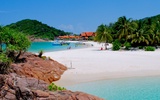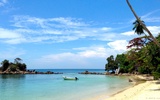Perhentian Islands (or "Pulau Perhentian") is on the east coast of Peninsular Malaysia and is about 21 kilometres off the coast of Terengganu and about 64 kilometres south of the Thailand border.
Perhentian consists of several islands, with the main ones being Pulau Perhentian Besar (“Big Perhentian Island”) and Pulau Perhentian Kecil (“Small Perhentian Island”). There are also five uninhabited islands in the archipelago, including Rawa, Serengeh and Susu Dara.
The name “Perhentian” comes from the Malay word meaning “stopping point”. The island used to be a stop off for merchants travelling between Thailand and Malaysia.
The islands are famous among backpackers wanting to go scuba diving or take snorkelling trips as there is plenty of cheap accommodation for budget travellers to family friendly leisure island resorts.

